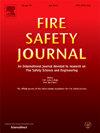Real-time semi-occluded fire detection and evacuation route generation: Leveraging instance segmentation for damage estimation
IF 3.4
3区 工程技术
Q2 ENGINEERING, CIVIL
引用次数: 0
Abstract
Disasters, such as building fires, pose substantial hazards to both human existence and ecological integrity. Existing methods sometimes fail to detect fires, especially semi-occluded fires. Simultaneously, there is a lack of methodologies to identify optimal evacuation routes and exit points during fire emergencies. Existing smoke alarms trigger too late, causing significant damage. Current methods also struggle to accurately depict instances of fire damage, requiring manual on-site assessments to estimate the extent of the destruction caused by fires. By using YOLOv8 to identify the fire and the Double Verification algorithm to assess the colour percentages within potential fire regions, the results show the effectiveness of our approach for semi-occluded fire detection. The YOLOv8 model, with a high confidence threshold (>50 %), could not detect the semi-occluded fires. The same YOLOv8 model with the lower threshold (>25 %) had improved detection but increased false positives. Our model, with lower confidence (>25 %) and double verification, outperformed, detecting semi-occluded fires with high precision and fewer false positives. Our model emerges as the effective choice, demonstrating superior accuracy (0.73) and F1 score (0.81) compared to the first two YOLOv8 models. In conclusion, the integration of our double verification algorithm with YOLOv8 notably improves detecting semi-occluded fires, achieving an 81 % detection rate. The safest path algorithm plays a vital role in generating a path that aids in the safe evacuation of individuals by identifying the safest exit routes. Employing instance segmentation techniques enables us to identify objects in a picture vulnerable to fire damage, facilitating a cost estimation process for further application.
实时半遮挡火灾探测和疏散路线生成:利用实例分割进行损伤估计
建筑火灾等灾害对人类生存和生态完整性都构成重大危害。现有的方法有时无法探测到火灾,特别是半遮挡火灾。同时,在火灾紧急情况下,缺乏确定最佳疏散路线和出口点的方法。现有的烟雾报警器触发太晚,造成重大损失。目前的方法也难以准确描述火灾造成的损失,需要人工现场评估来估计火灾造成的破坏程度。通过使用YOLOv8识别火灾和双重验证算法评估潜在火灾区域内的颜色百分比,结果表明我们的方法用于半遮挡火灾探测的有效性。YOLOv8模型具有高置信度阈值(> 50%),不能检测到半遮挡火灾。阈值较低(25%)的YOLOv8模型提高了检出率,但增加了假阳性。我们的模型具有较低的置信度(> 25%)和双重验证,以高精度和更少的误报检测半遮挡火灾。与前两个YOLOv8模型相比,我们的模型显示出更高的准确率(0.73)和F1分数(0.81),成为有效的选择。综上所述,我们的双重验证算法与YOLOv8的集成显著提高了对半遮挡火灾的检测,达到了81%的检测率。最安全路径算法通过确定最安全的出口路线,在生成有助于人员安全疏散的路径方面起着至关重要的作用。使用实例分割技术使我们能够识别图像中容易受到火灾损害的物体,从而便于进一步应用的成本估算过程。
本文章由计算机程序翻译,如有差异,请以英文原文为准。
求助全文
约1分钟内获得全文
求助全文
来源期刊

Fire Safety Journal
工程技术-材料科学:综合
CiteScore
5.70
自引率
9.70%
发文量
153
审稿时长
60 days
期刊介绍:
Fire Safety Journal is the leading publication dealing with all aspects of fire safety engineering. Its scope is purposefully wide, as it is deemed important to encourage papers from all sources within this multidisciplinary subject, thus providing a forum for its further development as a distinct engineering discipline. This is an essential step towards gaining a status equal to that enjoyed by the other engineering disciplines.
 求助内容:
求助内容: 应助结果提醒方式:
应助结果提醒方式:


